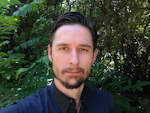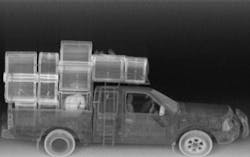According to an announcement released late June, American Science & Engineering (AS&E) reports the success of its Z Backscatter Van (ZBV) with over 400 sales in 46 countries. Its use varies "from seizures of large quantities of drugs, to the detection of stowaways and bulk explosives in war zones."
Placing such powerful contraband detection in a mobile unit has certainly deemed an advantageous tactic, for the company and law enforcement alike. Yet, its unusual name "Z Backscatter" stands out; at first glance its results seem to appear similar to X-ray images — perhaps not, take a second look.
Massachusetts-based AS&E was founded over 50 years ago by physicists from MIT. They originally formed the company to basically do a variety of research related activities primarily for the U.S. government in X-ray physics, science and technology, as stated by Joe Reiss, vice president of marketing at AS&E.
The company, initially ran as a research and development outfit, developed X-ray telescopes to aid in imaging the universe, CT scans for medical imaging as well as X-rays for security applications. From there, focus turned toward homeland security and the war on drugs — more specifically narcotic smuggling.
Looking to learn from history lest we repeat ourselves, AS&E was inspired from terrorist-like events of the past. For example, about three years ago the U.K. police uncovered liquid explosives — difficult to detect with X-ray.
Backscatter imaging, as compared to X-ray, transpires when X-rays bounce off of the scanned objects. Reiss explains: "[X-rays] could give you an image through things that visible light won't go through. Scientists have known for a long time that not only will X-rays go through objects but will scatter off objects as well." Putting the concept into use, ZBV sends out X-rays toward the target, the resulting "scattered" radiation is then translated into such black-and-white-type images viewed within this article.
To understand the contrast, in a typical "transmission" X-ray image, the higher density items appear while lower density objects print nearly translucent. "These transmission X-rays are great at locating heavy objects like guns or knives in bags, but then a new threat came along and that threat was explosive materials," he says.
The mass of the atom or atomic number of the material, closely associated to the conventional term "density," dictates how X-rays react with that material. "The reason why that's interesting is it turns out there are a lot of other things that are made up of 'lighter' atoms that law enforcement cares about — it could be explosive materials, narcotics, currency or a stowaway," he adds. Basically, these items are typically made of organic compounds which tend to scatter X-rays more.
While AS&E provides systems that utilize both transmission imaging and backscatter imaging, the ZBV only uses backscatter imaging in an effort to optimize detection.
Representing this optimization, the Associated Press reported that using a ZBV, Border Patrol agents discovered 1,500 pounds of hidden marijuana and five illegal immigrants in a hidden compartment of a large truck. In this example the marijuana appeared in the image a bright white-ish color due to its lower density qualities. (This example is not represented in the images included with this article.)
Presenting the technology's capabilities further, AS&E scanned one pallet of computer monitors with transmission X-ray and backscatter imaging at the same time to best display how the two display different pieces of the puzzle. One trick — they purposely placed bags of narcotic simulant around and in the monitors.
Transmission X-ray images displayed each monitor clearly; monitors were outlined, each metal component a very obvious image letting any analyst understand what objects were inside.
The backscatter results, however, illuminated the bags of narcotic simulant making any analyst aware of any organic-like material within.
Reiss hears that most people equate these to black and white photographs, and feels that helps to describe the ZBV images. In discussing a scan of a pickup truck with a stowaway: "You can see an image of a pickup truck, you can see kind of what looks like a person hiding in the back … [even if] you've never seen one of these before you can tell that's a person.
"Problems depend on where you are, whether it be a border security application or guarding against unlawful access, they can find people pretty easily," he adds.
At about six to seven miles an hour the ZBV is able to complete a scan of a passenger vehicle in up to 10 seconds. AS&E reports that its customers have used the van in a multitude of ways such as security procedures, securing public-event areas and vehicle-born IED detection.
In more customer examples, one agency was able to find a significant number of methamphetamine pills creatively hidden in an aftermarket rear-bumper on a vehicle, while another found barrels packed with sticks of dynamite. Like the luggage scans at the security checkpoint in airports, backscatter will not tell analysts what the material actually is — only that it is suspicious. "And that's the idea; a lot of times our customers can't do a physical search or bring in a dog team for every vehicle … it's just not practical," Reiss says. "This helps them target areas they think might pose a risk and that they want to investigate further."
Exposure
The U.S. set guidelines published by American Nuclear Society & Education and utilized by the FDA with the Center for Devices and Radiological Health and Health Physics Society. The guidelines set radiation exposure limits for non-medical X-ray exposures.
According to Reiss, the AS&E ZBV's radiation exposure is lower than published guidelines. The unsettling fact is we are exposed to radiation all the time; the exposure received from the ZBV, "is less than what you would get from flying in an airplane," he says. "Just from the cosmic rays of the universe, you get 200 times of exposure everyday as opposed to one scan."
Currently AS&E are in contract with the Technology Support Working Group, a Washington, D.C.-based national interagency research and development program for combating terrorism requirements at home and abroad, in efforts to develop solutions for the bomb squad community.
With 46 countries as customers, AS&E knows that each agency and demographic area presents a unique situation and issues. Aside from the already well-known X-ray scanning, "this technology gives them a tool that they just don't have otherwise," says Reiss. n
Editor's note: The Explosives Detection 2009 Symposium and Workshop will be held Oct. 20 to 23 in San Diego, Calif. Additional information can be found at www.tswg.gov.
Other successes
American Science & Engineering (AS&E) released a number of anecdotes from customers throughout the world describing their experiences using the Z Backscatter Van (ZBV).
- Iraq — Officials utilized two ZBVs along the borders of the Basra Province, according to a Colonel in the Multinational Division in UPI Energy in October 2007. The ZBVs operated as part of a security program to increase protection at ports of entry. The Colonel also noted that the ZBV's capabilities are significant enhancements to the traditional screening procedures.
- Singapore — The country's Immigration and Checkpoints Authority officers uncovered 1,484 cartons and 158 packets of smuggled cigarettes in a bus hidden under floorboards. The potential customs duties for the duty-unpaid cigarettes totaled about $79,000, according to AsiaOne in March of 2009. AsiaOne also reported in September of 2008 that the ZBV was used to interdict Singapore's largest haul of illegal tobacco products that year when a bus driver tried to smuggle them into the country through the Tuas Checkpoint.
- Middle East/Africa — Officials utilized the ZBV at a border crossing and found 1,042 kilograms of marijuana in the false wall of a delivery truck — the largest drug bust in the country's history, according to Al-Chourouk Newspaper in February of 2008. The ZBV clearly revealed the smuggled goods, and the security officials were able to seize the drugs, which had a street value of approximately $5 million.

Jonathan Kozlowski
Jonathan Kozlowski was with Officer.com, Law Enforcement Technology, and Law Enforcement Product News from August 2006 to 2020.
As former Managing Editor for Officer Media Group, he brought a dedicated focus to the production of the print publications and management of the Officer.com online product and company directory. You can connect with Jonathan through LinkedIn.
Jonathan participated as a judge for the 2019 and 2020 FOLIO: Eddie & Ozzie Awards. In 2012, he received an APEX Award of Excellence in the Technology & Science Writing category for his article on unmanned aerial vehicles (UAVs) in police work, aptly titled "No Runway Needed".



